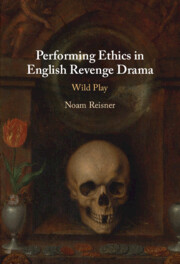Book contents
- Performing Ethics in English Revenge Drama
- Performing Ethics in English Revenge Drama
- Copyright page
- Dedication
- Contents
- Preface
- Introduction
- Chapter 1 Plot Holes and Empty Spaces
- Chapter 2 Dramatic Hyperboles
- Chapter 3 Wild Child’s Play
- Chapter 4 Marking the Ground of Revenge
- Chapter 5 Ghosting Shakespeare’s Hamlet
- Chapter 6 Passive Aggressors
- Epilogue
- Bibliography
- Index
Chapter 4 - Marking the Ground of Revenge
Hamlet’s Impasse and the Question of Spectator Guilt
Published online by Cambridge University Press: 09 July 2024
- Performing Ethics in English Revenge Drama
- Performing Ethics in English Revenge Drama
- Copyright page
- Dedication
- Contents
- Preface
- Introduction
- Chapter 1 Plot Holes and Empty Spaces
- Chapter 2 Dramatic Hyperboles
- Chapter 3 Wild Child’s Play
- Chapter 4 Marking the Ground of Revenge
- Chapter 5 Ghosting Shakespeare’s Hamlet
- Chapter 6 Passive Aggressors
- Epilogue
- Bibliography
- Index
Summary
Chapter 4 turns to the watershed moment of Shakespeare’s Hamlet as the great anti-revenge play of its day, which by commenting on Kyd’s design and its diminished capacity for novelty, profoundly changed it. In the process, Shakespeare’s play became itself an ethically vacant theatrical space in the dramatic continuum of the period, which subsequent playwrights responded to viscerally. This chapter argues that Shakespeare introduces into the intra-theatrical ethics of the standard revenge plot a theatrical ethics of ‘marking’ which seeks to translate through spectacle and performance what is merely shown into that which is, in the world, finally marked and bearing the trace of a wound or a scar. In the process, the chapter reflects on Shakespeare’s wider intervention in the dramatic fortunes of Kyd’s dramatic legacy in raising the stakes for audience participation in the action to new levels of guilt and vexed ethical complicity.
- Type
- Chapter
- Information
- Performing Ethics in English Revenge DramaWild Play, pp. 134 - 161Publisher: Cambridge University PressPrint publication year: 2024

